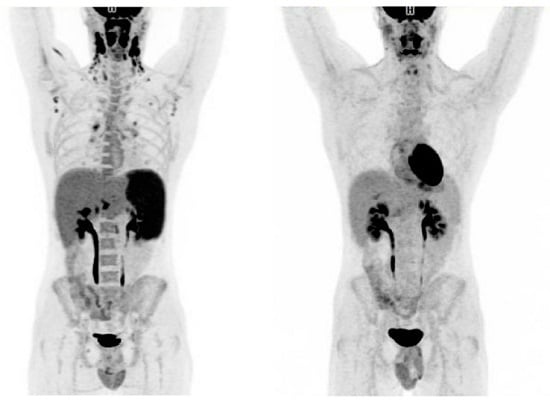18F-FDG PET/CT Findings in Acute Epstein-Barr Virus Infection Mimicking Malignant Lymphoma
Abstract
:

Conflicts of Interest
References
- Thomas, D.L.; Syrbu, S.; Graham, M.M. Epstein-Barr virus mimicking lymphoma on FDG-PET/CT. Clin. Nucl. Med. 2009, 34, 891–893. [Google Scholar] [CrossRef] [PubMed]
- Tamai, K.; Koyama, T.; Saga, T.; Umeoka, S.; Aoyama, A.; Hanaoka, N.; Fukuse, T.; Wada, H.; Tachibana, M.; Togashi, K. Posttransplant lymphoproliferative disorder in a lung transplant recipient. J. Thorac. Imaging 2005, 20, 280–283. [Google Scholar] [CrossRef] [PubMed]
- Tomas, M.B.; Tronco, G.G.; Karayalcin, G.; Palestro, C.J. 22. FDG uptake in infectious mononucleosis. Clin. Positron Imaging 2000, 3, 176. [Google Scholar] [CrossRef]
- Rosenbaum, S.J.; Lind, T.; Antoch, G.; Bockisch, A. False-positive FDG PET uptake-the role of PET/CT. Eur. Radiol. 2006, 16, 1054–1065. [Google Scholar] [CrossRef] [PubMed]
- Lustberg, M.B.; Aras, O.; Meisenberg, B.R. FDG PET/CT findings in acute adult mononucleosis mimicking malignant lymphoma. Eur. J. Haematol. 2008, 81, 154–156. [Google Scholar] [CrossRef] [PubMed]
- Jacene, H.A.; Stearns, V.; Wahl, R.L. Lymphadenopathy resulting from acute hepatitis C infection mimicking metastatic breast carcinoma on FDG PET/CT. Clin. Nucl. Med. 2006, 31, 379–381. [Google Scholar] [CrossRef] [PubMed]
© 2016 by the authors; licensee MDPI, Basel, Switzerland. This article is an open access article distributed under the terms and conditions of the Creative Commons Attribution (CC-BY) license (http://creativecommons.org/licenses/by/4.0/).
Share and Cite
Ørbæk, M.; Graff, J.; Markova, E.; Kronborg, G.; Lebech, A.-M. 18F-FDG PET/CT Findings in Acute Epstein-Barr Virus Infection Mimicking Malignant Lymphoma. Diagnostics 2016, 6, 18. https://doi.org/10.3390/diagnostics6020018
Ørbæk M, Graff J, Markova E, Kronborg G, Lebech A-M. 18F-FDG PET/CT Findings in Acute Epstein-Barr Virus Infection Mimicking Malignant Lymphoma. Diagnostics. 2016; 6(2):18. https://doi.org/10.3390/diagnostics6020018
Chicago/Turabian StyleØrbæk, Mathilde, Jesper Graff, Elena Markova, Gitte Kronborg, and Anne-Mette Lebech. 2016. "18F-FDG PET/CT Findings in Acute Epstein-Barr Virus Infection Mimicking Malignant Lymphoma" Diagnostics 6, no. 2: 18. https://doi.org/10.3390/diagnostics6020018
APA StyleØrbæk, M., Graff, J., Markova, E., Kronborg, G., & Lebech, A.-M. (2016). 18F-FDG PET/CT Findings in Acute Epstein-Barr Virus Infection Mimicking Malignant Lymphoma. Diagnostics, 6(2), 18. https://doi.org/10.3390/diagnostics6020018





